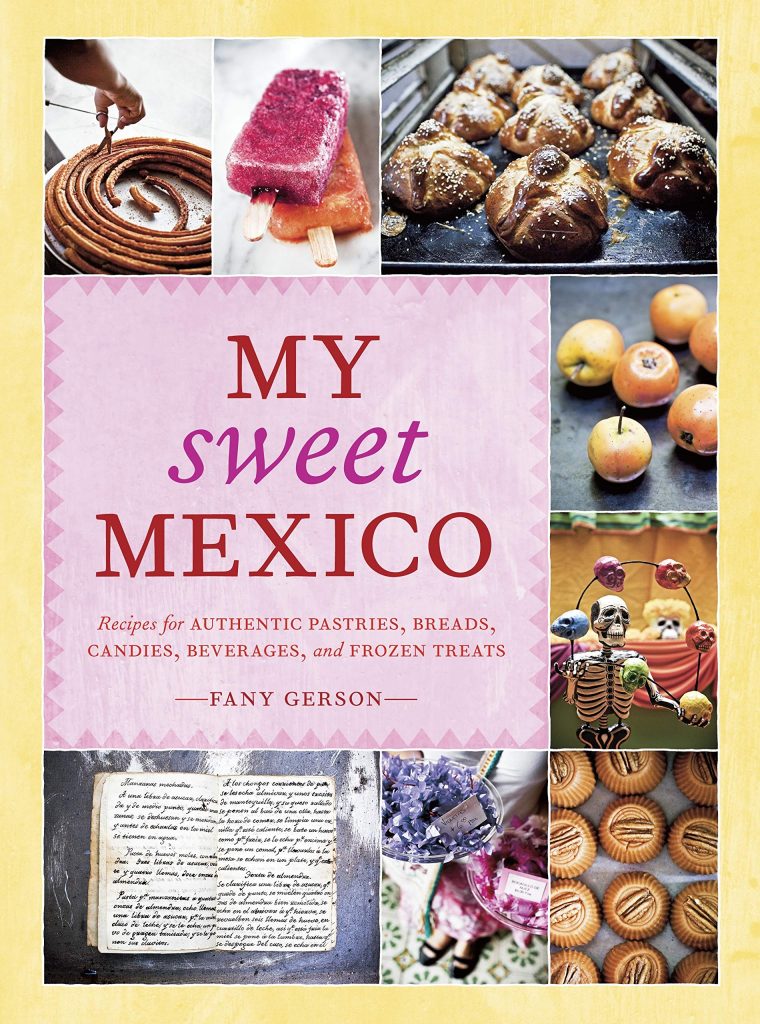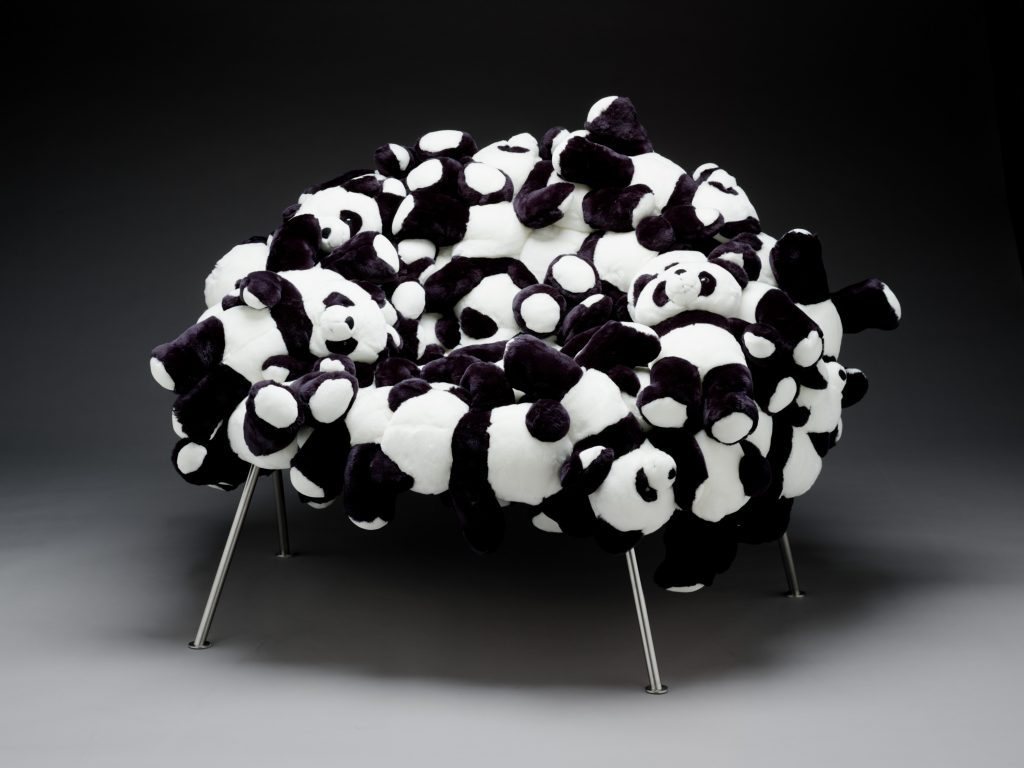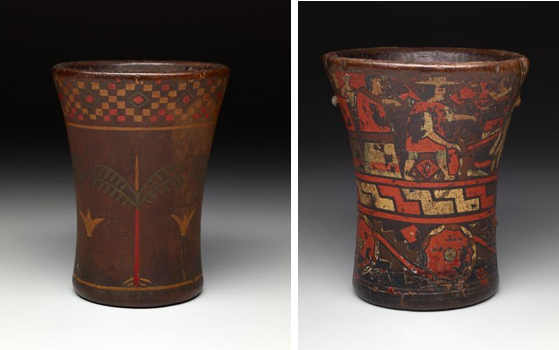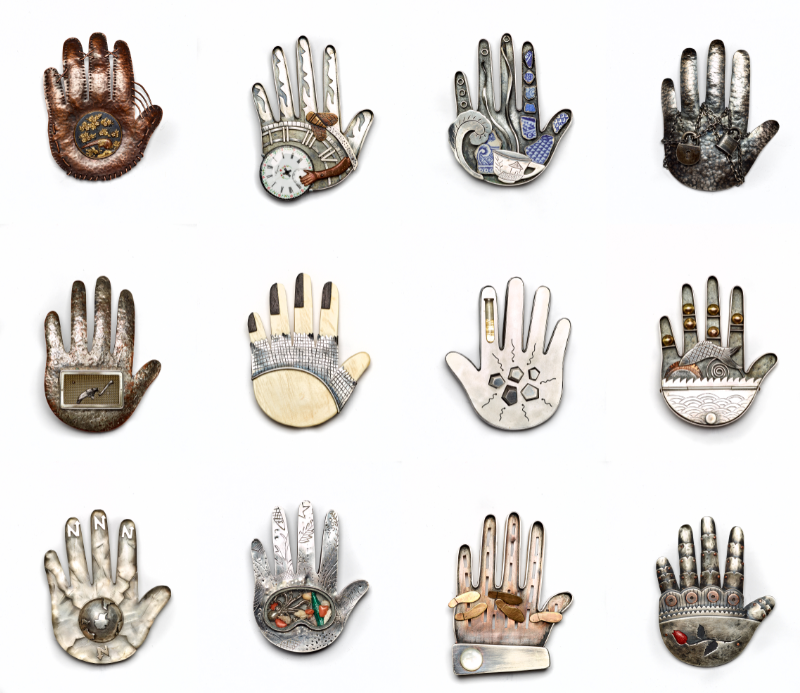Now on view in the exhibition To Be Determined, artist Jeffrey Gibson’s commissioned sculpture I WANNA STAY HERE WITH YOU FOREVER references themes of struggle, resilience, indigenous aesthetics, and the body. A member of the Mississippi Band of Choctaw Indians and half Cherokee, Gibson draws on the cultural hybridity of his own Native and queer identities to reflect on the experiences of love, fear, care, and longing in this work, part of a series of beaded punching bag sculptures. Take a behind-the-scenes look at how this work was created in his studio, from initial mockup to finished piece.
Archive Page 7
The Making of “I WANNA STAY HERE WITH YOU FOREVER”
Published October 8, 2020 Members , works of art Closed“I wish to commend you for accepting the commission to execute this painting which emphasizes the dignity of human nature. It is most appropriate that the people of the United States and Mexico are reaching one another’s cultures by mutual encouragement of the fine arts.”
This quote is from a telegram sent by the governor of Texas to Mexican artist Rufino Tamayo on the installation of his mural painting El Hombre at the Dallas Museum of Fine Art in October 1953. The genesis of the mural, commissioned by the Dallas Museum of Fine of Art, is directly related to the statements embodied in this quote.

Stanley Marcus, a long-time supporter of the Museum and president of the Museum’s Board of Trustees, had been trying to convince the Board that collecting Latin American art was a golden opportunity in advance of what would become mainstream status. Marcus had become close with artist Rufino Tamayo and his wife, Olga, after meeting through friends in Mexico and invited them to visit Dallas. A visit was planned for October 1951, with Marcus hosting the Tamayos prior to four days of lectures and events at the Museum.

They were expected to arrive in Dallas early in the evening from Amarillo, where Tamayo was giving a lecture. Marcus became increasingly concerned as the hours passed beyond their expected arrival time. When Rufino and Olga finally made it to the Marcus home late in the evening, they were clearly shaken and it was obvious something had happened. The Tamayos explained that their car had been hit, the other driver had called them by a racial slur, and the police charged them with the accident even though it wasn’t their fault. Tamayo was so appalled by the treatment they had endured that he didn’t think he wanted to do anything in the United States. Marcus responded that he thought it was a job for all of us to work to change the impressions that some Texans had of people from Mexico.
Marcus would go on to explain to Tamayo that one of his reasons for being interested in Mexican painting was because he thought that it was the key to establishing warm and understanding relations between the US and Mexico. Marcus once said in an Oral History interview in January 2002, “As you get to know more about the art and culture of the other countries, you begin to have respect for them. You have respect for the art, you have respect for the individuals who created it.”
Tamayo admitted that he had not thought of it that way. Marcus used this opportunity to extract a promise to create a large-scale painting, a mural, on a subject of the artist’s own devising. Tamayo even agreed to produce the mural for a fraction of his usual rate to accommodate the Museum’s lack of funds.
While Tamayo agreed to paint a mural for the DMFA in October 1951, he did not complete the work until the summer of 1953. El Hombre was briefly shown at the Salon de la Plastica Mexicana. In a review of the showing for the Mexico City newspaper Excelsior, Margarita Nelken wrote that the painting was a “transcendental work of the contemporary Mexican school.”


The painting arrived in Dallas on September 18, 1953—after a four-week train trip that included a delay due to flooding—and premiered on October 8 during the State Fair of Texas.
Hillary Bober is the Archivist at the DMA.
Connections Across Collections: Latin American Influence
Published September 25, 2020 American Art , Collections , Curatorial , works of art ClosedAs Hispanic Heritage Month continues, we’re spotlighting artworks and objects in our collection that were created with influence from Latin American culture and artists. We asked curators from across departments for their picks, and here’s what they had to say:
Sue Canterbury, The Pauline Gill Sullivan Curator of American Art
The year before settling in Taos, Emil Bisttram studied with Diego Rivera in Mexico. This painting’s volumetric forms and linear qualities evidence Rivera’s influence. It bears the hallmarks of Bisttram’s work from the early 1930s that often depicted Native Americans and the artist’s all-consuming interest in New Mexico’s architecture and landscape.

Dr. Michelle Rich, The Ellen and Harry S. Parker III Assistant Curator of the Arts of the Americas, and Dr. Mark A. Castro, The Jorge Baldor Curator of Latin American Art
Keros (ceremonial wooden cups from the Andes) in the DMA’s collection range in date from the 15th century through the Spanish viceregal period. As on the elegant kero with palm trees and flowers, their decoration can recall the geometric designs favored in the indigenous art of the pre-contact Inka Empire (for comparison, see this ceramic kero and checkerboard tunic). The cups, however, could also feature complex narratives. The kero with plowing scene depicts a man driving a plow ox, followed by two women: the first woman is planting seeds, and the second is ceremonially raising a pair of keros in the air (for more detail, see the rollout photograph of the upper portion).


Latinx Literature: An Arts & Letters Live Reading List
Published September 24, 2020 Arts & Letters Live ClosedTags: Dallas Museum of Art, DMA, Hispanic Heritage Month, Latinx Literature, literature, Reading list
Looking for some inspiration, a deeper dive into current issues, or your next favorite recipe? Here’s a list of books recommended by the Arts & Letters Live team honoring Hispanic Heritage month.
Fiction:
Afterlife by Julia Alvarez
Mexican Gothic by Silvia Moreno-Garcia
Dominicana by Angie Cruz

Nonfiction:
Silver, Sword, and Stone by Marie Arana
The Line Becomes a River: Dispatches from the Border by Francisco Cantú

Children’s Picture Books:
Love by Matt de la Peña and Loren Long
Dreamers by Yuyi Morales
Both authors and illustrators previously featured at Arts & Letters Live!

Young Adult Fiction:
We Are Not From Here by Jenny Torres Sanchez

Poetry:
Tertulia by Vincent Toro

Memoirs:
Where I Come From: Life Lessons from a Latino Chef by Aarón Sánchez
Native Country of the Heart by Cherríe Moraga

Cookbooks:
Muy Bueno: Three Generations of Authentic Mexican Flavor by Veronica Gonzalez-Smith and Evangelina Soza
My Sweet Mexico: Recipes for Authentic Pastries, Breads, Candies, Beverages, and Frozen Treats by Fany Gerson

Expanded for DMA Members: Connections Across Collections: Latin American Influence
Published September 23, 2020 Collections , Curatorial ClosedAs Hispanic Heritage Month continues, we’re spotlighting artworks and objects in our collection that were created with influence from Latin American culture and artists. We asked curators from across departments for their picks, and here’s what they had to say:
Sue Canterbury, The Pauline Gill Sullivan Curator of American Art
The year before settling in Taos, Emil Bisttram studied with Diego Rivera in Mexico. This painting’s volumetric forms and linear qualities evidence Rivera’s influence. It bears the hallmarks of Bisttram’s work from the early 1930s that often depicted Native Americans and the artist’s all-consuming interest in New Mexico’s architecture and landscape.

Julien Domercq, The Lillian and James H. Clark Assistant Curator of European Art
One of the highlights of our collection, the fabulous Bacchic Concert by 17th-century Italian artist Pietro Paolini spent about 100 years hanging on the walls of the Torre Tagle palace in Lima. It was part of an impressive collection of European paintings amassed in the early 19th century by a Peruvian diplomat; about 20 of these works are now owned by the DMA thanks to a gift of the Hoblitzelle Foundation.

Sarah Schleuning, Interim Chief Curator and The Margot B. Perot Senior Curator of Decorative Arts
Known for employing simple materials or common objects to create innovative contemporary furniture, Brazilian designers Fernando and Humberto Campana express their heritage through color, textures, and creative chaos. Here, inspired by their childhood, they use stuffed panda bears to envelop the sitter. Providing both physical and emotional comfort, the chair, they insist, is “about sitting. It’s design, not sculpture.”

Dr. Michelle Rich, The Ellen and Harry S. Parker III Assistant Curator of the Arts of the Americas, and Dr. Mark A. Castro, The Jorge Baldor Curator of Latin American Art
Keros (ceremonial wooden cups from the Andes) in the DMA’s collection range in date from the 15th century through the Spanish viceregal period. As on the elegant kero with palm trees and flowers, their decoration can recall the geometric designs favored in the indigenous art of the pre-contact Inka Empire (for comparison, see this ceramic kero and checkerboard tunic). The cups, however, could also feature complex narratives. The kero with plowing scene depicts a man driving a plow ox, followed by two women: the first woman is planting seeds, and the second is ceremonially raising a pair of keros in the air (for more detail, see the rollout photograph of the upper portion).


You Asked, They Answered! #AskaCurator Highlights
Published September 21, 2020 Curatorial , Dallas , Museum Insight , People , Staff ClosedTags: #AskaCurator Day, curator, Curatorial, Dallas Museum of Art, DMA
The DMA participated in #AskaCurator Day on Twitter last week—a day that harnessed the power of social media to connect our curators to just about anyone with a Twitter account and a burning question. Users tweeted their questions using the #AskaCurator hashtag for our seven participating curators to respond to. This resulted in a wide-ranging (and fun!) array of answers, from absurd museum gifs to personal anecdotes. Here are a few of the highlights:
Q: What is your favorite museum gif?
Q: How important is social media to seeing and finding new artists?
Q: What’s one of the weirdest paintings in your collection?
Q: What is your biggest “OMG I can’t believe I get to work/handle these object(s), pieces of history, etc.”?
Q: How have you done your job during the pandemic?
Follow us on Twitter to read through all of our #AskaCurator threads!

Dolores Velásquez Cueto, better known as Lola, began taking drawing and painting classes at the National School of Fine Arts in 1909, when she was just 12 years old. Two years later, against the backdrop of the Mexican Civil War, she became a student at the school full time, taking classes alongside such notable artists as David Alfaro Siqueiros, who himself was only one year older than her. Cueto was a voracious student, studying printmaking and other mediums at the National School, while also studying painting at the Open-Air Painting School in Santa Anita under the acclaimed painter Alfredo Ramos Martínez. She also began to teach drawing at a night school for workers, and her interest in education would continue throughout her life.
Cueto’s early work was praised by critics, raising her profile in the flourishing art scene in Mexico City. In 1919 she married fellow art student Germán Cueto Vidal, who would become one of the most well known experimental sculptors of the period. Their home was one of the city’s cultural hubs, where prominent artists and other cultural figures came to socialize.
Although Cueto continued to work in other mediums, she was increasingly drawn to tapestries, no doubt influenced by a childhood passion for embroidery. At the same time, she was part of a contemporary international trend—inspired in part by the Bauhaus—that sought to modernize historic artistic traditions using new techniques and technology. In her early tapestries, for example, Cueto used a sewing machine to create dense, precise embroidery with mercerized and silk threads.


Dr. Mark A. Castro is The Jorge Baldor Curator of Latin American Art at the DMA.
Expanded for DMA Members: Lola Cueto and the Modern Tapestry
Published September 10, 2020 Uncategorized Closed
Dolores Velásquez Cueto, better known as Lola, began taking drawing and painting classes at the National School of Fine Arts in 1909, when she was just 12 years old. Two years later, against the backdrop of the Mexican Civil War, she became a student at the school full time, taking classes alongside such notable artists as David Alfaro Siqueiros, who himself was only one year older than her. Cueto was a voracious student, studying printmaking and other mediums at the National School, while also studying painting at the Open-Air Painting School in Santa Anita under the acclaimed painter Alfredo Ramos Martínez. She also began to teach drawing at a night school for workers, and her interest in education would continue throughout her life.
Cueto’s early work was praised by critics, raising her profile in the flourishing art scene in Mexico City. In 1919 she married fellow art student Germán Cueto Vidal, who would become one of the most well known experimental sculptors of the period. Their home was one of the city’s cultural hubs, where prominent artists and other cultural figures came to socialize.
Although Cueto continued to work in other mediums, she was increasingly drawn to tapestries, no doubt influenced by a childhood passion for embroidery. At the same time, she was part of a contemporary international trend—inspired in part by the Bauhaus—that sought to modernize historic artistic traditions using new techniques and technology. In her early tapestries, for example, Cueto used a sewing machine to create dense, precise embroidery with mercerized and silk threads.

Cueto produced tapestries inspired by European sources, such as her famous series based on stained glass windows in the cathedrals in Chartres and Bourges, which the artist saw while living in Europe from 1927 to 1932. Many of her tapestries, however, draw on popular Mexican imagery, such as this fruit seller from Tehuantepec, in the southern state of Oaxaca. Celebrated for their independence and grace, native women in Tehuantepec wore distinctive garments that were adopted by a number of female artists, including María Izquierdo and Frida Kahlo.

Made while Cueto was living in Europe, this tapestry depicting an indigenous Oaxacan woman seems to draw a direct connection between the lush landscape and the woman’s cultural identity. The cream-colored fabric of her garments and the green of her jewelry are echoed in the dense foliage and in the mountains in the distance. The work recalls a larger ideology embraced after the Mexican Civil War that saw Mexican national identity as being drawn not just from the nation’s cultural traditions, but also from the unique qualities of its natural landscape.
Dr. Mark A. Castro is The Jorge Baldor Curator of Latin American Art at the DMA.
DMA Family at Home: Flores Florals
Published September 8, 2020 Art & Teaching , Creativity , Family Programs Closed
I was never the type of child to draw on the walls, but I’m sure if I had, my mom would not have responded with joy. Joy, however, is exactly what DMA’s Senior Graphic Designer Jaclyn Le was going for when she designed the floral pattern you can see on the walls in the DMA’s exhibition Flores Mexicanas: Women in Modern Mexican Art.

Jaclyn explains: “The hand-drawn floral pattern was inspired by Mexican lacquer ware from Olinalá. DMA Director, Agustín Arteaga, lent me a wonderful book full of different styles to look at, and I developed a monochromatic floral pattern illustrating common motifs I saw throughout the book. This floral pattern flanks both walls of the entrance to the exhibition and weaves its way up and over the ceiling in the space right before the monumental painting Flores Mexicanas by Alfredo Ramos Martínez.”
Now we aren’t advocating for your children to go crazy on the walls with a Sharpie, but Jaclyn’s process does offer another great way to engage your child with art. Sketching in the galleries is one of my favorite activities to do with kids because it encourages them to look closely, to engage their fine motor skills, and to be creative. In the classes I teach, sketching is never about reproducing an exact copy of the art on the walls—it’s about the process of connecting what a child sees and thinks with their pencil on paper, creating something new that wasn’t there before. Take a stroll through the virtual tour of Flores Mexicanas and challenge your child to find 3–4 different flowers in the paintings that they would like to draw in their own artful bouquet. Or, pull out a stack of favorite picture books or art books and have your child search for designs and patterns to incorporate into their own drawings.

ART ACTIVITY: MAKE A FLORAL PATTERN
To make floral patterns like those in the exhibition, watch this video tutorial and follow along with Jaclyn as she draws. Use any marker, sidewalk chalk, or drawing tool you have to create this. Here, Jaclyn is using a Crayola Superfine tip marker.
- Start by plotting three dots that will be the center of your flowers. You want to plot them with enough space in between—a triangle shape would be perfect for this.
- Draw a ring around each of the three dots. These will be the bases of the flowers to draw petals around.
- Start drawing the petals around each ring, with about 5-6 petals per flower. It’s okay if they are not all equal in size—it will look better this way in the end!
- Once all the petals of your three flowers are complete, draw 2-3 lines coming from the center ring to about halfway across each petal. This will give your flowers more depth and interest.
- In the negative spaces between your three completed flowers, draw a few slightly curved lines. These will be the stems of your leaves.
- Starting with the longest curved stem line, create a teardrop shape around the stem center. You can make these as wide or narrow as you’d like. Draw diagonal lines out from it to create the lines in the leaves. Do this for the other curved line stems from step 5, but save one of the stems for a fuller palm leaf drawing (in the next step).
- For the palm leaf, create simple leaves by drawing small curved strokes of lines, starting from the top of the stem and working your way to the base. These curved leaf lines will gradually get bigger and bigger with each stroke, as you make your way to the base.
- Complete your floral set by dropping in dots or circles in the spaces between the three flowers and leaves. Show us your creation by taking a picture and tagging #DMAatHome!
Bonus: Download our five floral coloring sheets for the kids to enjoy, inspired by the Dallas Museum of Art’s current exhibit, Flores Mexicanas.
Leah Hanson is the Director of Family, Youth, and School Programs at the DMA.
DMA Family at Home is supported by DFWChild.
The Figures Behind “Hands of the Heroes”
Published August 27, 2020 Contemporary Art , works of art ClosedTags: Dallas Museum of Art, DMA, Kiff Slemmons
The brooches in Kiff Slemmons Hands of the Heroes series, part of the exhibition Contemporary Art + Design: New Acquisitions, are each inspired by historical figures. Browse our round-up of interactive materials below to help you become familiar with the heroes represented and their historical significance.

Harry Houdini
- Read: Harry Houdini and the Art of Escape
- Watch: Houdini Bridge Jump with Handcuff Escape (1907)
- Watch: Harry Houdini – Straight Jacket Escape
Jacques Cousteau
- Watch/Rent (Prime): The Life Aquatic with Steve Zissou, a film by Texas director Wes Anderson inspired by the life and adventures of Jacques Cousteau.
- Read: 5 Surprising Facts About Jacques Cousteau
Marie Curie
- Read: Nobel Prize Lecture
- Read: Ten Historic Female Scientists You Should Know
- Short Watch: Marie Curie receive the ACR Gold Medal in 1931 the only known filmed recording of her voice
Marco Polo III
- Look: Portfolio of photos from Nat Geo Photographer Michael Yamashita, who traveled Marco Polo’s route and took photographs along the way
- Read: 11 Things You May Not Know About Marco Polo
Don Quixote
- Watch/Rent (Prime): Man of La Mancha
- Watch: The Impossible Dream scene of Man of La Mancha
- Read: Three Lessons Leaders Can Learn From Don Quixote About Strategizing
Glenn Gould
- Watch: Short documentary – Dear Glenn (Glenn Gould as A.I.)
- Watch: Glenn Gould performances from official website
Roald Amundsen
- Watch: Archival footage of Amundsen’s South Pole Expedition from National Geographic
- Read: 50 Daring Facts About Roald Amundsen
Louis Leakey II
- Read: Article from Smithsonian Magazine about Louis Leakey
- Read: Leakey and Goodall: Scientists Who Changed How We Define ‘Human’
Fred Astaire
Emily Dickinson
- Read: Atlas Obscura Article about a dessert Dickinson made frequently, including the original recipe
- Read: Major Characteristics of Dickinson’s Poetry from the Emily Dickinson Museum
Stephen Jay Gould
- Quiz: Take this Paleontology Quiz created by the Perot. Answer Sheet.
- Watch: Interview with Stephen Jay Gould from the Academy of Achievement
- Look: A photograph of Gould and Robert Rauschenberg together at an event
Joseph Cornell







